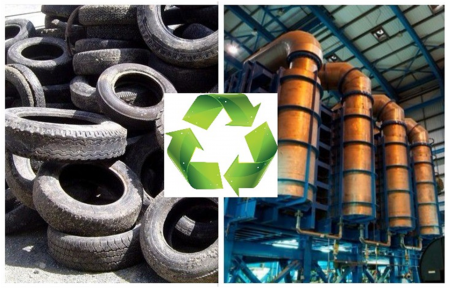January 29, 2018 – Today’s guest blogger is first-timer, Erich Lawson. Lawson is passionate about the environment and an advocate for effective recycling. He writes about these subjects on his blog site, Compactor Management Company, where you can learn more about the contribution recycling is making to a sustainable future. In this posting, Lawson writes about tire waste, an enormous environmental problem that produces over one billion end-of-life tires that either find their way to stockpiles or landfill sites. The current rate of scrap tire generation annually equals the number of people currently living in the United States. That’s more than 300 million every year. Turning this problem into a solution would be a good thing. As always feel free to comment to add to the conversation.

Tires are regularly discarded into landfill or stockpiled for future reuse. But today these discarded tires can be turned into fuels that are lower in emissions than other petroleum-derived products.
Tire-derived-fuels or TDFs can be created from scrap tires of all kinds including whole tires, or tires that have been processed into smaller, uniform pieces by using shredding equipment.
How Are TDFs Made?
There are two physical processing steps while processing tires:
- Shredding or Chipping – Tires are fed into a tire shredder. Generally, high-shear, low-torque shredders are employed to achieve this task. The whole tire is reduced to 2-inch pieces using either one tire shredder or a series of shredders.
- Metal Removal – The shredded bits are passed through screening and magnetic separation equipment to extract all metal pieces separating them from the rubber.
The shredded chip size of the tire is controlled by a screen kept in the discharge where approximately 5-centimeter (2-inch) sized pieces fall through screen openings while oversized material gets recirculated to the shredder for further cutting to get a uniform end size.
Some operations employ downstream shredding and wire removal to recover the entrained or lost rubber from the wire removal stream. This makes even the recovered steel resaleable for scrap, avoiding dumping it into landfill.
If smaller sized TDF-feedstock is required, shredding equipment capable of further reduction can be used.
What Are the Benefits of Using Tires as Fuel?
There are many benefits derived from turning tires into fuel. These include:
- Tires go from being a landfill problem to becoming an economic benefit.
- Creating fuel from tires means it doesn’t have to come from newly refined fossil fuels.
- Refining scrap tires is more economical then refining raw oil.
- Adding fuel derived from tires to traditional coal-fired cement kilns dramatically reduces greenhouse gas emissions including nitrous and sulfur pollutants while at the same time producing an ash that can be combined with the end product to make it both stronger and a means by which to permanently sequester carbon.
Where Are TDFs Used Today?
- Cement manufacturing – uses whole tires and TDF to supplement the primary fuel used in firing cement kilns. Whole or shredded tires serve as an excellent secondary fuel source while lowering the cost of energy in production, improving the quality of the end product, and reducing carbon pollution.
- Pulp and paper industry – uses TDF to supplement wood waste, the primary fuel used in pulp mill boilers. TDFs help decrease fuel costs and reduce emissions while at the same time improve combustion efficiency.
- Electric utilities – Use TDFs as a supplementary fuel to generate the heat in boiler operations. The higher heating value of TDFs, the competitive cost, the lower emissions and the ability to create stable operating conditions within boilers makes the fuel a great alternative for utilities operating thermal power plants.
- Industrial Boilers – in general manufacturing and production plants use TDFs as a heat source to turn steam into electricity.
- Tire-to-Energy Facilities (TTEF) – are dedicated facilities that use TDFs exclusively as their fuel source for electricity production. In the U.S. combusted tires have been used for nearly two decades this way and are responsible for removing 10 million tires from landfill annually. These TTEFs achieve lower emissions than utilities operating coal-fired thermal power plants.
What Are the Drawbacks?
The biggest challenge for TDF producers is storage and handling of the raw material. Tires left exposed to the environment consume a lot of land. They are water traps that can become breeding grounds for mosquitoes and the diseases these biting insects spread.
Harvesting tires from landfill sites presents additional problems. Hundreds of millions of tires have made their way into general purpose landfill today where their presence contributes to volatile greenhouse gas emissions in the form of methane, the single largest source for landfill fires.
So finding an economical way to retrieve and repurpose these abandoned, illegally dumped tires, could further reduce the human-generated garbage problem and produce a fuel capable of lowering greenhouse gas emissions and our dependency on fossil fuels.








